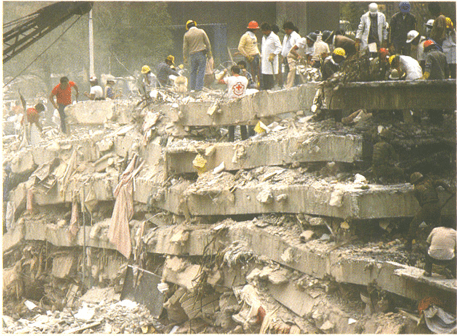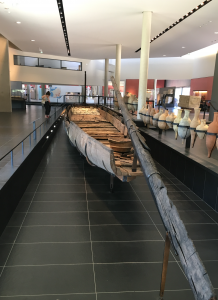“It is 7:19 am with 32 seconds central Mexico Time. It is still shaking a little, but let’s remain calm and wait a second so we can—…” These were the last words the people of Mexico City heard from Lourdes Guerrero, the face of Televisa’s morning news before their televisions cut to static. The next ninety seconds would not only change Mexico City forever but it would define a whole generation’s governmental standards.1
For the people of the Mexican capital, Thursday September 19, 1985 began like any other day. It was 53 degrees; the sky was clear, and at just a little after 7:00 am, children were arriving at schools, adults were going to work, and the city was beginning to wake up for another day.2 Suddenly at 7:19 am, the worst earthquake to ever strike the city unleashed on the Mexican people, and for ninety seconds, the capital experienced the full force of mother nature. Measuring 8.1 on the Richter scale, the earthquake moved whole concrete buildings and crushed entire apartment complexes, effectively trapping the people inside.3

Prior to the arrival of the Spaniards in 1521, the Aztecs had built their capital, Tenochtitlan, over Lake Texcoco. “Over the years, this man-made island has paid the price for building over a lake with soft soil. Every year since its establishment, Mexico City has been steadily sinking into the fragile soil,” and when earthquake waves arrive in the areas around the city, they are amplified by a factor of 100, causing the damage to be worse than it would be in any other soil.4 On the morning that terror struck, Mexico City felt the magnitude of an earthquake that developed off the coast of Michoacán. The earthquake waves reached the capital with a magnitude of 8.1 on the Richter scale, but created much greater damage than any other earthquake before.5
After the earthquake, the citizens began to assess the damage and the long and difficult road towards recovery. Almost instinctively, they started moving rocks and debris from people and liberating some who were trapped.6 Within hours, the citizens noticed the poor response from the government, especially from president Miguel De la Madrid, who had not publicly spoken about the tragedy. As the day went on, the number of people missing increased as well as the impatience of the citizens as police and the military were unable to get organized and froze, leaving the relief efforts completely in the hands of the citizens.7
In the north of the city, the General Hospital had lost its entire OBGYN (obstetrician and Gynecology) wing, trapping mothers who had just given birth as well as their new born babies. Sylvia Reyna, a nurse working at the hospital, gave her testimony about how doctors, nurses, and anyone who was willing to help rushed to start looking for survivors. “Every time someone got out alive, we cheered and celebrated with happiness, but when we pulled a lifeless body, everyone was silent.”8 Scenes like this one were not isolated. All throughout the city there was more than 100,000 homes and buildings destroyed by the earthquake that ultimately trapped people inside. Famous city landmarks, like the famous Regis Hotel and the country’s most important television network headquarters, had been crushed, ultimately cutting the city’s most important form of communication with the outside world. Although the death toll for the first day is still unknown, many believe the number is in the tens of thousands.9

With over 250,000 people left without a home, and no response from the government, the citizens united to take over the search and rescue to find those who were missing.10 Women brought pots and pans and cooked for the volunteers, doctors and nurses created makeshift hospitals to treat the injured, and crime was controlled by the citizens. The first 24 hours after the earthquake put incredible pressure on the government to respond, and as media outlets around the world started spreading the news of the earthquake, the pressure put on the president was raised.
Without the government’s assistance, various groups like the now famous Topos de Tlatelonco formed in order to help dig out people. Although nowadays the Topos are an established organization famous for their heroic assistance all around the world, in 1985 they were just a citizen-based group volunteering to help the people still trapped inside the buildings. During the terrible earthquake in 1985, these men and women earned the nickname “topos,” which means “moles,” for their incredible ability to go into the rubble to help those inside. Today, more than thirty years after the tragedy in Mexico City, this official organization has traveled all across the world to help in disasters, such as the earthquake in Haiti in 2010, and the Tsunami in Indonesia of 2004.11
The progress of the initial day was incredibly inspiring as hundreds of people had been rescued and the city was united to overcome the terrible tragedy. However, they were not prepared for the 7.1 magnitude aftershock that arrived 36 hours after the initial quake. On the evening of September 20, as many citizens dug in the ruins of apartment complexes and wandered around the city looking for their loved ones, the capital was struck with another earthquake that completely halted the recovery and forced many to start over. The aftershock made the buildings that had earlier collapsed settle, which made it much harder to rescue those who were still trapped. Although the damage from the second quake was incalculable, the second earthquake left citizens more afraid and scared than the first one. Citizens once again flooded the streets and dropped to their knees to pray for it to stop.12
With yet another earthquake, and pressure from his people, President Miguel De la Madrid first spoke publicly about the earthquake three entire days after the initial earthquake happened. His response outraged the citizens as De la Madrid downplayed the number of injured and dead in front of the world media and refused to accept aid from countries around the world who offered to help.13 One of his initial responses was also to send the military and police to disrupt the progress citizens had made by blocking off many buildings and restricting access to volunteer groups such as the Topos de Tlatelonco. By doing so, he effectively stopped the search and rescue of hundreds of individuals who were still trapped and injured days after the quake.14 His actions only angered the people more, and many citizens recalled the soldiers actively looting in the ruins of hotels and apartment buildings, taking all the safe boxes and jewels they could find.

Although the exact death toll was never given, some estimate it to be between 10,000-40,000.15 In the aftermath of the historic earthquake, the government was forced to implement building safety codes and regulations as well as an early-earthquake alarm system to ensure people will get out of structures safely. Similarly, after incredible pressure from citizens and other countries, Mexico ultimately accepted help from the United States, insuring that people would receive the much needed help. Nowadays in Mexico City and in the surrounding municipalities, people continue to regularly practice evacuation. Schools and offices hold earthquake drills regularly to ensure the events of 1985 won’t happen again.
The citizens did their best to move on, and return to normalcy as soon as possible. Despite living among the incredible destruction, they went to mass, they returned to work, they began reconstruction and prayed for those who were still missing. Now more than thirty years after the terrible events brought the capital to its knees, the damaged areas show no evidence of the destruction, with only monuments left to remind them of the tragedy that took place.16
- Encyclopedia of Latin American History and Culture, June 2008, s.v. “Earthquakes,” by Jürgen Buchenau. ↵
- “Weather history for MMMX Thursday September 19, 1985,” Weather underground, Accessed April 12, 2018. https://www.wunderground.com/history/airport/MMMX/1985/9/19/DailyHistory.html?&reqdb.zip=&reqdb.magic=&reqdb.wmo=. ↵
- Elena Poniatowska, Nothing nobody: the voices of the Mexico City Earthquake (Philadelphia, Temple University press, 1995), 13. ↵
- Michael Kimmelman, “Mexico City, parched and sinking, faces a water crisis,” The New York Times (New York City, NY), February 17, 2017; Lucy Jones, interview by Judy Woodruff, PBS News Hour: Why Mexico City is vulnerable to earthquakes, September 20,2017. ↵
- Historical Dictionary of Mexico, 2008, s.v. “Earthquake of 1985,” by Marvin Alisky. ↵
- Alan Riding, “A year after the quake, Mexico City Is on the mend,” The New York Times (New York City, NY), September 20, 1986. ↵
- Daniel Hernandez, “The 1985 Mexico City Earthquake, Remembered,” Los Angeles Times, September 20, 2010. ↵
- Elena Poniatowska, Nothing nobody: the voices of the Mexico City Earthquake (Philadelphia, Temple University press, 1995), 19. ↵
- Encyclopedia of Urban Studies, 2010, s.v. “Mexico City, Mexico: History of the city,” by Adrian Guillermo Aguilar and Ailasa Winton. ↵
- Encyclopedia Britannica, September 20, 2017, s.v. “Mexico City earthquake of 1985.” ↵
- “Historia,” Brigada de rescate Topos de Tlatelonco, accessed April 10, 2018. http://www.topos.mx/nosotros/historia. ↵
- Rosalía Guerrero, interview by Guillermo Guerrero, La replica del 20 de Septiembre de 1985, Chilango, September 18, 2015. ↵
- Elena Poniatowska, Nothing nobody: the voices of the Mexico City Earthquake (Philadelphia, Temple University press, 1995), 24. ↵
- “El Universal,” Miguel De La Madrid, El Presidente ‘ausente’ En Tragedia Del 85 | Red Política – El Universal. September 19, 2004. Accessed April 13, 2018. http://www.redpolitica.mx/nacion/miguel-de-la-madrid-el-presidente-ausente-en-tragedia-del-85. ↵
- Alan Riding, “A year after the quake, Mexico City Is on the mend,” The New York Times (New York City, NY), September 20, 1986. ↵
- David Adler, “The Mexico City earthquake, 30 years on: have lessons been forgotten?,” The Guardian (Mexico City, Mexico), September 18, 2015. ↵



47 comments
Irene Astran
Natural disasters will only continue to plague our coasts if we do not take the necessary precautions to combat them. It really starts with us. Many people believe that us recycling or carpooling a little more will answer for these problems, but it does not stop there. At one point this past couple months there were seven ongoing hurricanes. We cannot allow this to continue. We should do all that we can to direct efforts toward preventing, not reacting to natural disasters.
Max Lerma
Great article! I had heard of this earthquake before and knew of its destructive capacity, but until I read your article, I had no idea just how horrific the damage was. I think it is appalling that the president of Mexico not only did not help but actively sought ways to slow the recovery efforts. Thank you for this informative read and for making such a devastating story of human history one that continually grabs your attention.
Ximena Mondragon
Overall, this article is very interesting and it gets to the point. The author did a great job at explaining this tragic moment in Mexico’s history however this article could have been more impactful if a testimony of a person was provided. My mother was actually in Mexico when this happened and she said it was scary. She remembers seeing all the buildings moving and the cars moving.
Donte Joseph
Seeing that this article has to do with earthquakes, I immediately resonated with it since my mother who was from the Philippines had to experience many earthquakes. It is sad that many people had to suffer because the government too so long to respond to the tragedy. What was settling for me was reading how the people who suffered came together and helped each other out. Many ups and downs throughout the story but overall a great read.
Valeria Perez
The further I read into the article the angrier I got at the poor organization, involvement, and support the Mexican people received from the government. Though I did have previous knowledge about this incident I did not know the magnitude of the damaged caused by it. I admire the citizens response for this and their selflessness in trying to help others and their efforts to rebuild their city.
Madeline Torres
This article kept me on the edge of my seat and wanting it to continue and continue. It’s so heartbreaking to read about the wing of the hospital with moms and babies being collapsed. I cannot believe that Mexico’s government took so long to respond to such horrible tragedy. It’s amazing how quickly the Mexican people worked together to hep each other in such horrible times. Seems to be that Mexico has always had a failing government.
Luisa Ortiz
1. My mother was just a little girl when the earthquake in the 80’s happened also she just moved out of Mexico City to Veracruz when the earthquake hit, so she just barely miss it, thank God! Everyone including her remembers that devastating catastrophe date until today’s date! I also heard that after the earthquake many businesses did not recuperate as they went out of business. This Article has great imagines and I really like how you incorporate a video, great job!
Caden Floyd
This article was very informative and descriptive of what happened on this tragic day. I had never heard of the Mexico City earthquake before reading this article. I was hooked from the beginning line. The president seemed like a real slouch for not accepting aid and not being completely truthful to his people. It makes me upset because there was so many people harmed and they had no idea their lives would change forever that day. But the people came together and helped themselves when government had failed them.
Alexandra Lopez
This article was well written and informed the reader about the aftermath of that horrible earthquake that had occurred in Mexico City. It is terrifying that one minute you are reporting the news or walking down the street and then suddenly one of worst earthquakes in your country’s history hits. In a city as large as it is, it had a devastating effect.
Luis Magana
Having family in Mexico City it brings shivers to my body if something like the earthquake in 1985 would happen again. I had heard about this earthquake before reading the article but I wasn’t very aware of the small details. Its very devastating what the people in Mexico City had to live through and the effects the earthquake had. It shows how something so dramatic could happen in an instant so you should live day by day appreciating everything big or small.